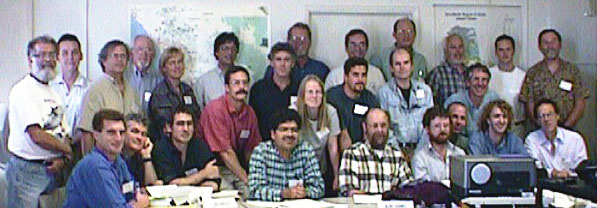Open vs. closed marine populations: Synthesis and analysis of the evidence
Project Description
The major unanswered question in marine ecology is the degree of connectedness between local populations. Put another way, what proportion of young arriving into a local population are products of local production? What is the source of recruits for any local population, and where do the young produced in a local population go? The answers to these questions are unknown for any widespread species with a pelagic dispersal phase. Proper marine management depends on knowledge in this area: the efficacy of any reserve design, for example, is highly dependent on the degree to which it is dependent on other populations for recruitment, and the degree to which it supplies other areas.
Since most marine animals have a pelagic larval stage, the paradigm thus far has been to assume extensive dispersal and massive export. In contrast, I suggest that evidence is accumulating in a variety of fields (detailed below) that indicates a surprising amount of local retention, even in species with long larval durations. If such retention turns out to be a common feature of local marine population dynamics, this will require major reassessment of marine metapopulation models, fishery management schemes, marine reserve designs, and ideas about the mechanisms of marine speciation. It is time to assess the evidence for open populations (i.e., strongly connected local populations, best approached through metapopulation models) vs. closed populations (i.e., dependent on local production, similar to many terrestrial systems) in the marine environment.
An assessment of the prevalence of open vs. closed populations has been hampered by the diverse nature of the evidence. Many workers have pieces of the puzzle, and we need to gather them together. This proposal has two components:
1. A working group will convene to identify and share the most important areas of evidence, sources of data, and common methods of analysis. This group will consist of workers in the following areas:
¿ life-history characteristics of endemic species
¿ geographic genetic structure of marine populations
¿ patterns of spread of introduced species
¿larval distributions, ecology and behavior
¿ near-shore oceanography
¿ marine paleoecology
¿ empirical studies of recruitment
¿ proximal effects of marine reserves
2. As a Center Fellow, I will coordinate the group and work with NCEAS staff to help the group to gain access to and synthesize the evidence. Many in this group will not have realized the connections between their disciplines until they meet over this common problem, and most will not have analyzed their data from the perspective of open vs. closed populations. One of the most important tasks of this group will be to assess the evidence critically: what is evidence to indicate the degree of retention in a marine population, and what are alternative explanations for the patterns seen?

Principal Investigator(s)
Project Dates
Start: January 9, 1999
End: June 23, 2000
completed
Participants
- George Boehlert
- Pacific Fisheries Environmental Laboratory
- Ronald Burton
- University of California, San Diego
- James T. Carlton
- Williams College
- Robert K. Cowen
- University of Miami
- Ginny Eckert
- University of Alaska Southeast
- Bella Galil
- Israel Oceanographic and Limnological Research (IOLR)
- Churchill B. Grimes
- NOAA, National Marine Fisheries Service (NMFS)
- Dennis Hedgecock
- University of California, Davis
- Michael E. Hellberg
- Louisiana State University
- Terence P. Hughes
- James Cook University
- Jeremy B.C. Jackson
- University of California, San Diego
- Geoffrey P. Jones
- James Cook University
- Michael J. Kingsford
- University of Sydney
- Armand Kuris
- University of California, Santa Barbara
- Jeffrey M. Leis
- Australian Museum
- Ken Lindeman
- University of Miami
- Steven Morgan
- University of California, Davis
- John L. Munro
- Worldfish/ICLARM
- Joseph E. Neigel
- University of Southwest Louisiana
- Stephen R. Palumbi
- Harvard University
- John M. Pandolfi
- Smithsonian Institution
- Jesus Pineda
- Woods Hole Oceanographic Institution
- Callum Roberts
- University of York
- D. Ross Robertson
- Smithsonian Tropical Research Institute
- Kaustuv Roy
- University of California, San Diego
- Gregory M. Ruiz
- Smithsonian Environmental Research Center
- Kimberly A. Selkoe
- University of California, Santa Barbara
- Alan L. Shanks
- University of Oregon
- Jeffrey Shima
- University of California, Santa Barbara
- Su Sponaugle
- University of Miami
- Richard R. Strathmann
- Friday Harbor Labs
- Stephen E. Swearer
- University of California, Santa Barbara
- Simon Thorrold
- Old Dominion University
- Robert R. Warner
- University of California, Santa Barbara
Products
-
Journal Article / 2002
Genetic assessment of connectivity among marine populations
-
Journal Article / 2002
Sensory environments, larval abilities and local self-recruitment
-
Journal Article / 2002
Predicting self-recruitment in marine populations: Biophysical correlates and mechanisms
-
Journal Article / 2002
Evolution of local recruitment and its consequences for marine populations
-
Journal Article / 2002
Evidence of self-recruitment in demersal marine populations
-
Journal Article / 2002
Quantifying larval retention and connectivity in marine populations with artificial and natural markers
-
Presentations / 2000
Open vs. closed marine populations: Synthesis and analysis of the evidence, 30 August 2000
-
Presentations / 2001
Using past marine reserve performance as a guide for effective design, 17 February 2001
-
Journal Article / 2002
Local retention of production in marine populations: Evidence, mechanisms, and consequences
